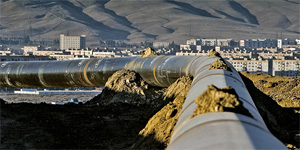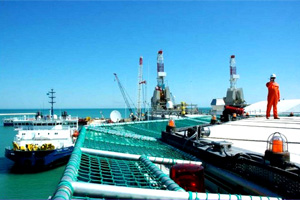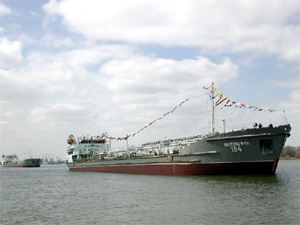EU must take action to secure Caspian oil
EU must take action to secure Caspian oil
The two national companies of Kazachstan and Azerbaijan – KazMunayGas (KMG) and State Oil Company of the Azerbaijan Republic (SOCAR) – have signed several agreements to create a legal and commercial basis for the Trans-Caspian Project, also known as the Trans-Caspian Oil Transportation System (TCOTS). The latest step forward was announced early in June when a pre-qualification round was started for feasibility studies. The TCOTS is important as a major new source of oil supplies in Europe. It has strong backing of the major oil companies, including European companies, operating in the Caspian region and it is backed by the governments of Azerbaijan and Kazakhstan. What is lacking so far, however, is clear support from the EU and the US. This makes it possible for Russia and Iran to undermine the project. High time for Brussels to take action.
 |
|
The Baku-Tbilisi-Ceyhan oil pipeline was one of the successes of the EU and the US in securing Caspian oil for the West. |
One of the successes of Europe and the US in the Caspian region has been the construction of the Baku–Tbilisi–Ceyhan (BTC) oil pipeline, which brings oil from the Caspian Sea through Azerbaijan and Georgia to Turkey, without involvement from either Russia or Iran. It has a capacity of 1 million barrels a day (total EU oil consumption is about 14 million barrels a day). Kazachstan, however, has the potential
| The battle over the gas and oil resources in the Caspian Sea region is also taking place on other fronts |
French support
The Kashagan field of Kazakhstan is one of the largest hydrocarbon fields in the world with an estimated 9 to 13 billion barrels of recoverable reserves. That’s almost twice as much as the proved reserves of a country like Norway, and enough to supply all of the oil demand of a country like the UK for 20 years. In addition, in Kazakhstan the second phase of the Tengiz and Karachaganak fields are being developed, with an export capacity of 1 million barrels per day.
 |
| Construction of an oil platform on the Kashagan oil field. The Kashagan field will enable Kazakhstan to export massive amounts of oil in the future. |
Plans for the creation of a trans-Caspian westbound route for oil export were first adopted in 2005 by the government of Kazakhstan. On 16 June 2006, the President of Kazakhstan, Nursultan Nazarbayev, signed a framework agreement with the President of Azerbaijan, Ilham Aliyev, on the Trans-Caspian Oil Transport System (TCOTS). This agreement also included the intention to develop a Europe-Caucasus-Asia corridor. On 24 January 2007, the partners in TengizChevroil, the developer of the Tengiz field, which include Chevron, ExxonMobil and KazMunayGaz, and the Kashagan field developer KCO, a subsidiary of ENI, signed a memorandum of understanding to create the TCOTS. On 2 October 2009, KazMunayGaz and SOCAR (State Oil Company of the Azerbaijan Republic) signed a memorandum of understanding to expand the TCOTS to include Azeri infrastructure and onshore pipelines from Baku to the Kulevi oil terminal in Georgia on the Black Sea coast.
On 6 October 2009, an agreement on the proposed seabed oil pipeline from Kashagan to Baku was signed by a consortium of French companies during a visit of French President Nicolas Sarkozy to Kazakhstan. This was an important sign of support, as French oil company Total has a share in both the Kashagan field and the BTC pipeline. Total has estimated that the pipeline would cost roughly US$4
| Both Iran and Russia remain opposed to TCOTS on environmental grounds, but the real reason is that both are seeking to exercise control over the flow of oil |
With the construction of the pipeline still uncertain, however, there is a second option that is being pursued and that looks more feasible in the short run. This is to build oil terminals on the coast of Kazakhstan and then use oil tankers to transport the oil to Azerbaijan. This option, which will likely be operational in 2012, will enable Kazakhstan to transport through the BTC pipeline twenty three million tons of oil each year (460,000 barrels per day). It will transform the small Kazakh processing port of Kuryk, located 70 kilometers south of the regional capital Aktau in the Mangystau peninsula (one of the country’s most isolated regions), to a hub of Kazakh oil exports and economic development. It will receive the oil through a 600-kilometer pipeline from the reserves of Atyrau, located further to the north. A complex system of barges will then carry the oil to Azerbaijan, where the consortium will establish storage structures and connections to the BTC. The Azerbaijani authorities are strongly opposed to any delay by Kazakhstan of this project, which is important for Baku’s geopolitical positioning toward Europe. The capacity of this system can be raised later up to 750,000 - 1.2 million barrels per day (35-56 million tons per year), although to transport these volumes the construction of a second leg of the BTC pipeline would eventually be required.
Vested interest
So what would be the most desirable option from the economic point of view? Shipment by tankers is the default mode in the initial phase. Two options are available at present within that framework. The first relies on the existing fleets of small-capacity oil tankers owned by shippers in Azerbaijan and Kazakhstan. As a rule, these are Soviet-era vessels of the "river-and-sea" type, originally designed for service in the former Soviet Union's inland and coastal waters, with a capacity of less than 10,000 tons. The Caspian Shipping (Caspar) company in Azerbaijan is the clear leader in this area, with almost 40 oil tankers carrying small-time volumes for big-time fees from the eastern shore to Baku. Azerbaijan proposes to acquire additional tankers in order to serve the TCOTS and even to involve shipping companies from other countries in the oil tanker line between Kazakhstan and Azerbaijan, once the oil shipment volumes rise towards the first-stage target of 23 million tons.
 |
| A typical small Russian oil tanker that is being employed on the Caspian Sea. |
A seabed pipeline, on the other hand, becomes commercially profitable at an annual volume of 20 million ton (400,000 barrels per day), according to the project's feasibility assessment which was made in 2004. However, given oil price dynamics since that time and into the foreseeable future, the profitability threshold is probably now significantly below that threshold. It may be noted that as four of the shareholding companies in the Kashagan consortium – Agip, Total, ConocoPhillips, and Inpex – are also shareholders in the BTC pipeline company, this overlap increases the chances of an adequate execution of the pipeline.
Commercial production at the Kashagan field is expected to start in 2013 at an annual rate of 7 million tons ("early oil"), rising to 13 million tons annually by 2017 and reaching 50 million tons per year after 2020. Thus, tanker transportation will be neither sufficient nor cost-effective after 2016-2017. It would even become an obstacle to the pipeline project by splitting volumes and creating an entrenched vested-interest constituency. Unsurprisingly, shipping interests favour tanker shipment, rather than a seabed pipeline, as the final choice for the TCOTS, but it seems clear that, while relying on tanker shipments for the initial phase of the transport system, Azerbaijan and Kazakhstan as well as their partners ought to make a political and strategic choice for a seabed pipeline.
It may also be noted in this context that the chairman of SOCAR, Natig Aliev, has proposed enlarging BTC's capacity by 70% by using chemical agents and building additional pumping stations to carry the inputs from Kazakhstan. In addition, part of the additional volumes from Kazakhstan can also be routed to Georgian ports on the Black Sea for shipment to Ukraine or Romania, and on to Central European countries. Ukraine favours this solution in order to support the Odessa-Brody-Gdansk project. For its part, Romania has large unused or underused refining capacities that could handle oil shipped from Kazakhstan via Georgia.
Real reason
The future of the TCOTS is important for Europe’s policy of diversification of energy supplies. The construction of a pipeline is obviously in the European interest, but it is by no means settled. Until there is a multilateral agreement on the division of the Caspian by the five littoral states, a trans-Caspian oil transport system will necessarily be limited to barge traffic. A resolution on the legal status of the Caspian Sea and a division of its resources is, however, being held up mainly by Iran’s insistence on a share far larger than geography would indicate. The debate over the division of the Caspian Sea has, in fact, become a proxy battle over oil and gas transit revenues. Both Iran and Russia remain opposed to TCOTS on environmental grounds, but the real reason is that both are seeking to exercise control over the flow of oil. Having lost the “BTC war” to keep Azerbaijan from exporting its oil to world markets via Turkey (rather than via Russia or Iran), neither the Russian nor Iranian governments are inclined to let Kazakhstan and its enormous oil volumes slip away without a fight.
In addition to this legal struggle over the Caspian Sea, the battle over the gas and oil resources in the Caspian Sea region is also taking place on other fronts. One is the volatile western Caspian (the South Caucasus) which, unlike the largely peaceful eastern part of the Caspian, has remained explosive, due to a number of still-unsettled territorial disputes in which Russia has played a part. The most recent
| If the the US and the EU take action, the TCOTS will most likely be built, and it will carry the majority of Kazakhstan oil to the West |
Another significant front in the Caspian battle is the struggle over the CPC (Caspian Pipeline Consortium) pipeline, in which both the Russian government and western oil companies participate. The CPC pipeline carried 31 million tons of oil from Kazakhstan to Russia in 2006, surpassing the line’s first-phase capacity of 27 million tons, though still less than one half of the line’s planned second-phase capacity of 67 million tons. The western shareholders (including Agip/Eni and ExxonMobil) want to see the volume expanded, but the Russian government’s inter-agency group, which has a majority in the joint-venture, is resisting this. By the Russian group’s controversial accounting, the CPC consortium – that is basically the Western companies – is currently $5 billion in the red. Moscow’s onerous terms on CPC’s western shareholders and consequent the uncertainty over the export outlets, has become a factor in delaying the production schedule at Tengiz and the start of production at Kashagan. According to data released by TengizChevroil, its production declined from 13.6 million tons in 2005 to 13.3 million tons in 2006, instead of the planned second-phase production ramp-up.
There are still other ways in which the complex geopolitics of the Caspian Sea might play out. For example, the TCOTS could be linked to the Russian, Chinese, and Iranian oil systems. This would allow Kashagan oil to flow via alternative pipeline systems and eliminate the need for an expansion of the BTC. This obviously would not be in the interest of the EU and the US. Their combined diplomatic and economic power would forestall such a scenario. If they take action, the TCOTS will most likely be built, and it will carry the majority of Kazakhstan oil to the West.
|
About the author Ramiz Mammadov is a Planning & Reporting Engineer in Agip KCO, a subsidiary of ENI and a partner in the North Caspian Operating Company (NCOC). He is a former planning analyst in the Russian aluminium company RUSAL, in KeppelFels Azerbaijan and in Baku Interbank Currency Exchange. He holds an MBA in Economics from Western University in Baku, Azerbaijan. |